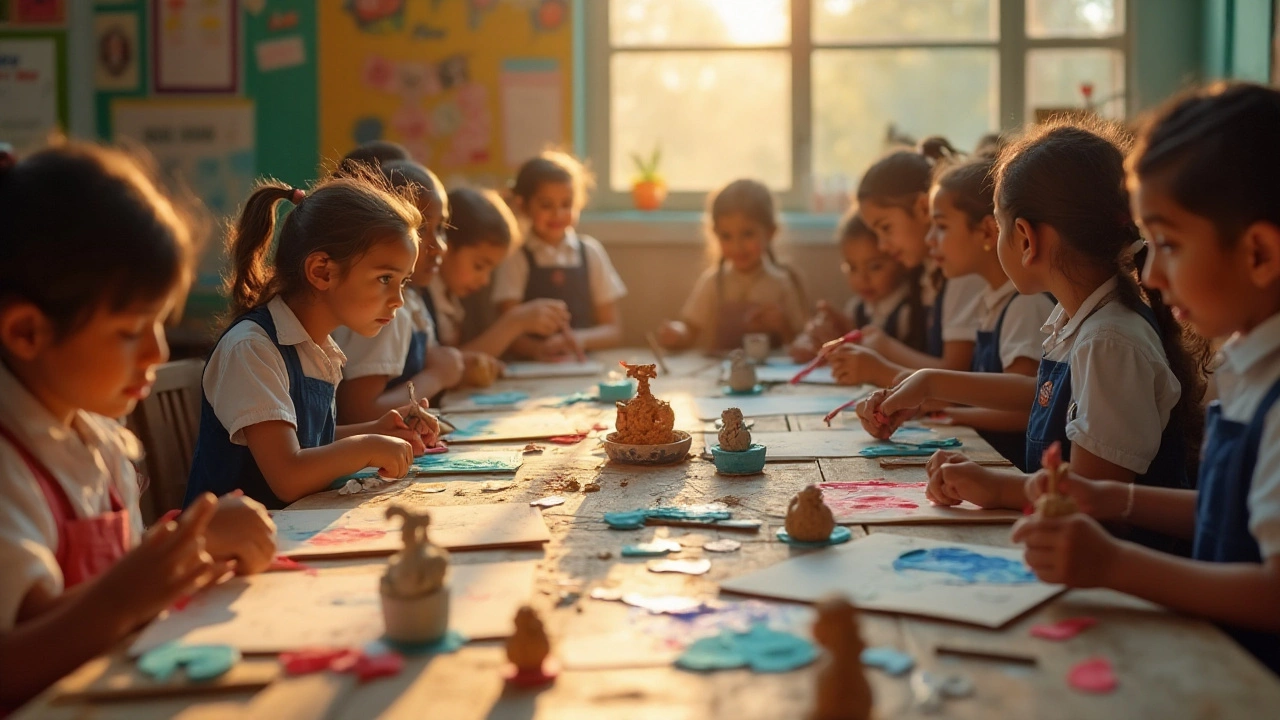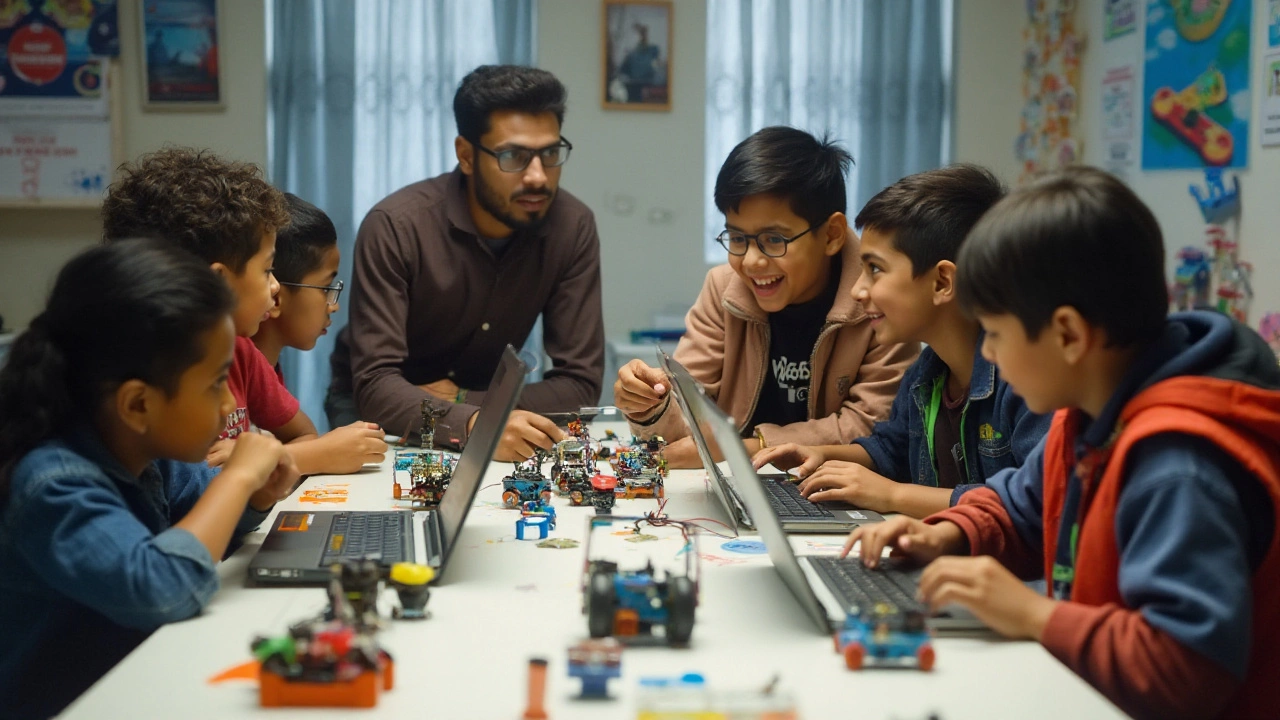
- Created by: Lydia Carmichael
- Completed on: 29 Jan 2025
- Categories: Youth Programs
After-school clubs are an excellent way for children to explore new interests and hone skills beyond the regular school curriculum. These clubs open doors to a variety of activities that can be both educational and fun.
Creative arts clubs let kids dive into painting, drama, or music, fostering self-expression and creativity. On the other hand, STEM programs captivate young minds with robotics, coding, and science projects, ensuring learning never stops and instead becomes thoroughly engaging.
Sports teams are perfect for those needing to blow off steam while learning the value of teamwork and discipline. Meanwhile, language and culture clubs offer a delightful exploration into new worlds, providing both cognitive and social benefits.
Environmental and nature groups teach kids the importance of caring for our planet by actively participating in outdoor activities and ecological projects. Finally, for those who may need a bit of help in forging friendships, social skills development clubs cultivate empathy and communication through group activities.
- Creative Arts Clubs
- STEM Programs
- Sports Teams
- Language and Culture Clubs
- Environmental and Nature Groups
- Social Skills Development
Creative Arts Clubs
Diving into creative arts clubs is like opening a treasure chest of imagination and expression for kids. These clubs encompass a range of activities such as drawing, painting, sculpture, theater, dance, and music. Each club offers a distinctive way for children to express themselves. By engaging in art-related clubs, young minds can sharpen their creativity, develop problem-solving skills, and boost their confidence. Several studies highlight how participation in the arts can positively impact brain development, fostering skills like critical thinking and innovation that are crucial in today's ever-evolving world.
One interesting aspect of these clubs is their ability to cater to various interests, encouraging children to explore and find their artistic niche. For instance, drawing and painting clubs enable kids to translate their thoughts onto canvas, experimenting with colors and techniques. Drama clubs give them a platform to articulate emotions through performance, guiding them to understand human experiences in exciting ways. Dance clubs are another popular choice, where rhythm and movement allow children to express joy and creativity physically. Such physical activities are known to improve coordination and overall health.
Music clubs deserve a special mention too. Learning an instrument or singing as part of a choir can tremendously enrich a child's cognitive and emotional growth. It has been noted that children involved in music tend to perform better academically, not to mention the sheer joy it brings. An article from the American Psychological Association states,
"Engaging with music not only enhances the auditory skills but also leads to better performance in memory and attention tasks."This powerful benefit is just one of many reasons to encourage participation in arts and music after-school clubs. Kids not only have fun and make friends but also learn to appreciate culture and history through various art forms.
These clubs are particularly advantageous because they offer a safe space for children to express their individuality without judgment. It is here that introverted children might find their voice through art, and extroverted ones learn patience and focus. The diverse nature of activities within extracurricular activities means no two days are the same, and young participants frequently leave with newfound skills and friendships. Social interactions in this setting often lead to stronger communication skills, helping children articulate and convey their ideas effectively.
For parents looking to encourage creativity in their children, researching and enrolling in a club that resonates with their child’s interest level is the key. Whether it’s painting imaginary worlds or acting out plays, the importance of these clubs in child development is immense. They are invaluable opportunities for can children to gain confidence and develop a passion that could last a lifetime. Emphasizing creativity in after school clubs contributes significantly to a well-rounded education, equipping children with competencies that reach far beyond mere academia. If engaging activities, ample creativity, and educational benefits check your boxes, creative arts clubs are certainly worth considering.
STEM Programs
STEM programs, focusing on Science, Technology, Engineering, and Mathematics, capture the essence of innovation and curiosity. These after school clubs not only reinforce academic learning but make it vivid and exciting for kids. Engaging in these activities, children learn to address real-world challenges with creative solutions. This style of education goes beyond typical classroom settings, promoting an inquisitive mind and a hands-on approach to problem-solving where concepts like physics or algebra transform into playful experiments or intriguing puzzles.
For many youngsters, STEM clubs are like an adventure into the world of possibilities. Here, they can join robotics teams, where they learn to construct and program robots for competitions. Coding clubs take it further, allowing kids to create their own games or applications, fostering both analytical thinking and digital literacy. These clubs often use block coding platforms for beginners, easing them into more advanced programming languages as they grow more confident. As a result, future architects and engineers are being nurtured in spaces they find enjoyable and captivating.
Beyond robotics and coding, other activities include experimenting with chemistry sets, participating in science fairs, or even engaging in design challenges that involve building bridges or towers. Such initiatives often provide significant encouragement for aspiring scientists. As an example, a study by the National Science Foundation highlighted that early exposure to STEM fields can influence a child's choice in pursuing tech-focused careers later in life. Fostering an environment of trial-and-error, these clubs teach resilience — when a model car doesn’t work as expected, it's a journey of figuring out why, and enjoying the discovery just as much as the solution.
In many STEM after-school programs, educators emphasize teamwork and collaboration. Students work in small groups where sharing ideas and skills leads to profound learning experiences. This group work models real-life professional scenarios, where collaborative innovation can lead to groundbreaking discoveries. By pushing boundaries together, kids build not only gadgets or projects but also friendships and a sense of community. The rewards come not only from building something new but also through the shared joy of creation.
The effectiveness of such programs often relies on engaging mentorship. Guidance from enthusiastic instructors who are passionate about STEM topics can spark wonder and excitement among the students. Inspirational figures in these roles often create an empowering atmosphere. An insightful quote from Neil deGrasse Tyson captures this essence:
"The good thing about science is that it's true whether or not you believe in it."This embraces a culture where questions are welcomed, and exploration is celebrated. The goal is nurturing lifelong learners who enjoy the pursuit of knowledge even beyond school years.

Sports Teams
Joining sports teams is one of the most popular after-school activities, providing children with a unique blend of exercise, camaraderie, and life lessons. Whether it's soccer, basketball, or swimming, every sport gifts young athletes with invaluable skills. Practicing on a field or court teaches them discipline and the importance of time management, as they balance training with homework and family commitments. Being part of a team promotes a sense of belonging and responsibility, where each child's unique strengths contribute to the collective effort.
Participating in sports teams not only bolsters physical fitness but also enhances mental resilience. Children learn to handle competition, celebrate wins gracefully, and accept losses with dignity. Such experiences build character and forge resilience, preparing them for various life challenges. A Harvard study suggests that regular participation in sports can improve children's academic performance, highlighting how physical activity sharpens their focus and determination. Moreover, sports naturally develop leadership qualities; encouraging young athletes to take the lead can translate into becoming influential leaders in community and career spheres later in life.
Apart from individual growth, the bonds formed among team members are significant. Shared goals and mutual support during games foster deep friendships that often last beyond school years. These connections teach the essence of empathy and cooperation, traits valuable in any future endeavor. Parents often observe noticeable improvements in their child's behavior and maturity once they engage in regular sports activities because they learn from real-time consequences and peer interactions.
The variety of sports teams available today offers options to suit every child's interest and capability. If your child isn't keen on mainstream sports like football or baseball, introducing them to martial arts or fencing might just spark their enthusiasm. Encouraging children to try different sports helps them make specialized choices, ensuring they engage in an activity they genuinely enjoy and excel at. According to the National Federation of State High School Associations, over 7.9 million students participated in sports activities in 2023, showcasing the colossal interest and importance placed on sporting endeavors in schools.
As the celebrated coach Vince Lombardi once said, "The measure of who we are is what we do with what we have." This philosophy underscores the essence of sports — making the most of each child's potential.
In the pursuit of a balanced and healthy lifestyle for our children, enrolling them in sports teams can be a cornerstone. It nurtures both their physical and psychological growth, imparting them with memories, friendships, and skills that last a lifetime. Often, the impact of these experiences goes beyond the confines of the schoolyard, influencing personal and professional realms in ways parents and educators might never anticipate.
Language and Culture Clubs
Language and culture clubs open a unique window for children to view the world with new eyes. These clubs aren't just about learning a new language; they're about immersing in an entire spectrum of cultural richness, which can be a transformative experience for young minds. By participating in these clubs, children learn the nuances of different languages and gain exposure to diverse cultural practices, histories, and traditions. This holistic approach fosters not only cognitive development but also empathy and understanding of global diversity, crucial skills in today's interconnected world.
In these clubs, kids often engage in fun activities like cooking traditional dishes, participating in cultural festivals, and even learning native dances. Such experiences encourage them to appreciate and respect differences, fostering a sense of global citizenship from an early age. One of the fascinating aspects these clubs might offer is participation in language exchange programs, where children engage in conversations with peers from different countries, enhancing their language proficiency and cultural understanding simultaneously. Language and culture clubs thus become a platform for active, experiential learning.
According to a study by the American Council on the Teaching of Foreign Languages, students who study a foreign language not only score higher in their academic endeavors but also exhibit better problem-solving skills and creativity. It's about more than just communication; it's about understanding the world in a myriad of expressions.
“To have another language is to possess a second soul,” remarked Charlemagne, encapsulating the value of linguistic diversity and cultural awareness.Language and culture clubs embody this philosophy, nurturing a second soul within the participants.
The impact of these clubs extends beyond mere language acquisition. Socially, children develop better communication skills and become more comfortable in multicultural settings, preparing them for future pursuits, both academically and professionally. Moreover, these clubs often inculcate a passion for travel and exploration, as kids learn about different countries and their unique customs. Extracurricular activities like these play a vital role in shaping open-minded and culturally sensitive individuals.
Another exciting aspect of language and culture clubs is the exposure to various art forms, literature, and folklore from different cultures, which broadens a child's horizon, giving them insight into a world beyond their immediate experience. Youngsters participate in storytelling sessions, acting out folk tales, or appreciating international cinema, thereby linking them with others’ narratives in a personal way. Parent and child interactions often improve as families might participate in cultural events together, enhancing familial bonding through shared experiences.

Environmental and Nature Groups
Environmental and nature groups have recently seen a surge in popularity among after-school clubs, and for good reason. They provide a unique opportunity for children to connect with the environment and develop a love for the natural world. These activities immerse kids in projects that range from planting community gardens to organizing clean-up drives in local parks. By getting their hands dirty, children learn firsthand about ecological systems and the importance of preserving our planet for future generations.
Activities within these clubs are often hands-on and engaging, encouraging kids to actively participate in nurturing their surroundings. Whether it’s constructing habitats for pollinators or learning about native plant species, the variety ensures there’s something to captivate all interests. The clubs nurture a sense of responsibility and inspire young environmentalists through direct interaction with nature.
One exciting aspect of these groups is their ability to teach practical skills. Children learn how to compost, identify wildlife, and understand seasonal changes through real-world experiences. For example, they could start with a small project like documenting local bird species, which eventually grows into a larger passion for ornithology. By regularly observing their environment, kids become more aware and appreciative of the world around them.
In addition to the skills and knowledge they gain, children also benefit from an increase in physical activity, which is vital for their overall health. These clubs offer a respite from screens and a chance to enjoy the great outdoors. It's been shown that children who play outside are more likely to have better concentration levels and improved moods. According to a study published in Nature Research, regular outdoor activities can enhance cognitive functions and emotional well-being.
"Kids today really need nature more than ever. It's vital for their health and development," says Richard Louv, author of Last Child in the Woods.
Beyond the personal benefits, these after-school clubs also foster a sense of community. Children learn the value of teamwork as they embark on projects that improve their local environment. Working alongside peers, they develop social skills and make lasting friendships. Parents often notice a boost in their child's confidence and empathy as they see firsthand the impact of their efforts.
Moreover, statistics from the Child Mind Institute suggest that children who spend more time in nature often have reduced anxiety and stress levels. Regular engagement with the environment provides a calming effect and helps instill a lifelong love for the great outdoors. By investing time in environmental and nature groups, children not only grow into conscientious individuals but also become advocates for the planet, all while having fun along the way.
Social Skills Development
Social skills development clubs are wonderful spaces where children learn how to communicate effectively, develop empathy, and foster meaningful relationships. In today's fast-paced world, where digital interactions often take precedence over face-to-face conversations, these clubs provide a much-needed platform for children to practice and perfect their interpersonal skills. Participating in these clubs not only helps children interact confidently with peers and adults but also promotes emotional intelligence. They engage in activities that teach the art of active listening, taking turns in conversations, and respecting diverse perspectives.
One of the most significant benefits of social skills clubs is their effect on a child's ability to adapt to various social settings. Kids participate in role-playing exercises and group projects, where they learn to navigate different social scenarios in a safe, supportive environment. Such experiences are designed with the goal of boosting their self-esteem and reducing anxiety in unfamiliar situations. Imagine a shy child who, after a few sessions, starts voicing their thoughts during group discussions, or the overly zealous one who learns the balance of listening and responding appropriately.
According to a study by the American Psychological Association, children who engage in structured social activities show a marked improvement in their ability to manage emotions and deal with conflicts constructively.
"Social competence is a critical developmental milestone, essential for both academic success and overall well-being," says Dr. Susan Smetana, an expert in child psychology.This underlines the importance of providing opportunities for kids to grow such skills from a young age.
Social skills development clubs often feature dynamic, interactive workshops that involve storytelling, games, and cooperative tasks. These activities not only keep the participants engaged but also provide practical scenarios where conflicts may arise, allowing children to solve problems collaboratively. Beyond just verbal communication, these clubs give attention to non-verbal cues like body language and facial expressions—essential components of effective communication that often go unnoticed by young learners.
The benefits of these clubs transcend the boundaries of the activity itself. By nurturing a sense of empathy and understanding complex social dynamics, participants often exhibit better adaptability to group settings in educational contexts and beyond. The skills acquired are not only limited to enhancing interpersonal relationships but are also instrumental when faced with challenges such as public speaking, teamwork, and leadership roles. Parents often note an improvement in children's behavior at home as a reflection of the skills developed at these clubs.
In conclusion, social skills development clubs are pivotal in equipping children with the necessary tools to navigate social landscapes with ease and confidence. These skills are not just pivotal during childhood but lay the foundation for building respectful, considerate individuals in the future. It's fascinating to watch a child blossom from being reserved in expression to someone who participates actively in conversations, with a newfound perspective on how to tackle interpersonal issues. Such transformation beautifully encapsulates the essence of what social skills development clubs strive to achieve.